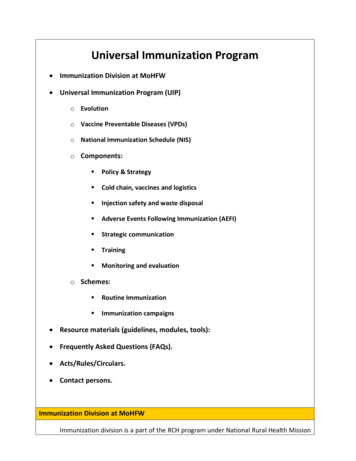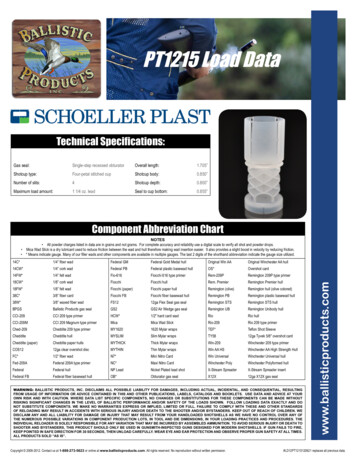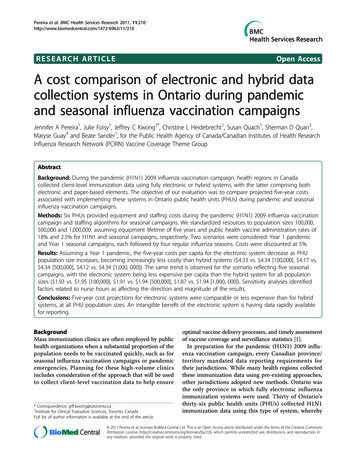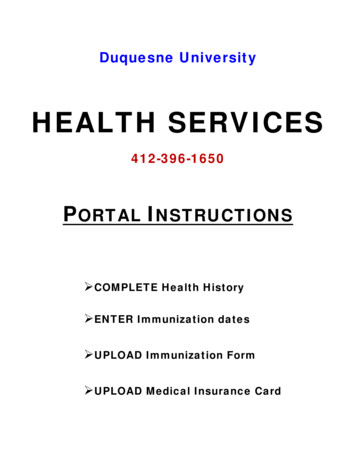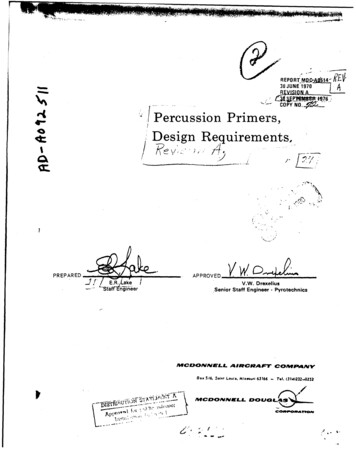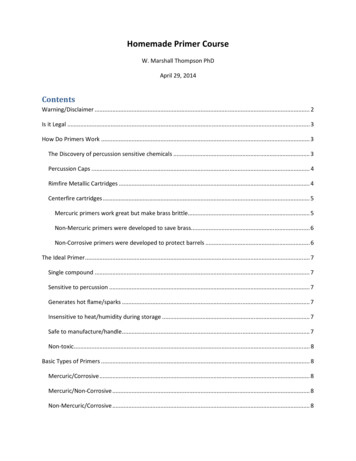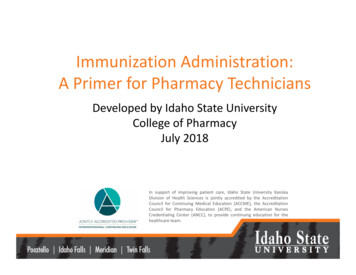
Transcription
Immunization Administration:A Primer for Pharmacy TechniciansDeveloped by Idaho State UniversityCollege of PharmacyJuly 2018In support of improving patient care, Idaho State University KasiskaDivision of Health Sciences is jointly accredited by the AccreditationCouncil for Continuing Medical Education (ACCME), the AccreditationCouncil for Pharmacy Education (ACPE), and the American NursesCredentialing Center (ANCC), to provide continuing education for thehealthcare team.1
Disclosure Statement The planners and presenters of this presentationhave disclosed no conflict of interest, including norelevant financial relationships with anycommercial interests
Objectives Identify the appropriate type, dosage, and route ofadministration of various vaccines Describe the role of a pharmacy technician inadministering immunizations Implement appropriate procedures for storage ofvaccines, patient documentation, and evaluation ofpotential contraindications for vaccines Demonstrate proper technique for preparing andadministering immunizations3
What the State of Idaho Allows. An Immunizing pharmacist may delegate the technical task of administering animmunization to a certified technician under their supervision who:– Holds a current certification in basic life support for healthcare providersoffered by the American Heart Association or a comparable Board‐recognizedcertification program that includes cardiopulmonary resuscitation (CPR) andautomated electronic defibrillator (AED) training and requires a hands‐onskills assessment by an authorized instructor; and– Has successfully completed a course on appropriate immunizationadministration technique by an ACPE‐accredited provider or a comparablecourse; or– Has successfully completed the pharmacist qualifications specified under thisrule– Rule 330.3 was recently cut, but the intent to receive training that is in linewith best practice is still required1. Rules of the Idaho Board of Pharmacy [Internet]. 2017 [cited 16 March 2017].4
Technicians 1 Must be a certified technician Be delegated by the pharmacist to provideimmunizations– “To susceptible persons six (6) years of age or olderfor the protection of communicable disease” BLS for Providers that includes:– CPR and AED training– Hands‐on skill assessment Completed a course on appropriate immunizationadministration techniques1. Rules of the Idaho Board of Pharmacy [Internet]. 2017 [cited 16 March 2017].5
Vaccines A vaccine is a product that stimulates a person’s immune system toproduce immunity to a specific disease, protecting the person fromthat disease Vaccines are made using the disease‐causing virus or bacteria, butare weakened or killed to prompt the immune system to developantibodies against the disease Outbreaks of vaccine‐preventable diseases can and still do happenacross the United States Centers for Disease Control (CDC) and Food and Drug Administration(FDA) ensure vaccine safety Vaccines are not just for children and can help protect adults withspecific health conditions Are safe, effective, and work with your body’s immune system toprevent disease6
Immunity through vaccines Live attenuated vaccines– Attenuate: “procedures that weaken a pathogen toreduce the severity of disease”– Pathogen can still replicate which helps elicit a morepronounced immune response– Weakened pathogen usually doesn’t cause disease– Contraindicated in immunocompromised patients Cancer, pregnancy, HIV, corticosteroid use7
Immunity through vaccines Inactivated (or killed) vaccines– Can be fragments of viruses or bacteria Can be whole viruses or bacteria– Antigens are recognized which elicits theimmune response– Cannot cause disease– Do not produce as strong of an immuneresponse Ex. Yearly flu shots8
Timing and spacing of VaccinesAntigen CombinationRecommended minimum intervalbetween dosesTwo or more inactivated vaccinesCan be administeredsimultaneously or at any intervalbetween dosesInactivated and liveCan be administeredsimultaneously or at any intervalbetween dosesTwo or more live intranasal orinjectable4‐week minimum, interval if notadministered simultaneously9
How have immunizations shapedthe world? Prior to vaccines, almost everyone gotmeasles and chickenpox 1921 diphtheria outbreak killed 15,000Americans Rubella (German measles) wasresponsible for 2,000 infant deaths and11,000 miscarriages between 1964 and1965 Small pox killed an estimated 300million people in the 20th century10
11
Current Available ococcalSmallpoxDiphtheriaMumpsTetanusHepatitis APertussisTuberculosisHepatitis BPneumococcalTyphoid FeverHaemophilusinfluenza type BPolioVaricellaHumanPapillomavirusRabiesYellow FeverSeasonal InfluenzaRotavirusJapaneseEncephalitisRubella12
Commonly administered vaccinations Hepatitis A Hepatitis B Influenza– Trivalent– Quadravlent Meningitis Pneumonia– Pneumovax – Prevnar13 Shingles– Zostavax – Shingrix Tdap (Tetanus, Diphtheria and Pertussis) Varicella13
Influenza Flu season– October – May Incubation period/Onset ofsymptoms– 1 to 4 days Symptoms and complications– Fever– Non‐productive cough– Body aches– Chills– Fatigue and malaise– Headache14
Influenza 2017‐2018 Trivalent:– A/Michigan/45/2015 (H1N1)‐like virus– A/Hong Kong/4801/2014 (H3N2)‐like virus– B/Brisbane/60/2008‐like virus (Victoria lineage) Quadravalent:– Same as above B/Phuket/3073/2013‐like virus(Yamagata lineage)15
2016‐2017 Updates: Influenza Egg allergies 2015‐2016– Egg allergies are very common in children Reactions leading to death are very rare– Update: no longer necessary to screen for eggallergies– One less barrier to getting immunized16
ACIP Recommendations for Egg Allergies Persons with a history of egg allergy who have experienced onlyhives after exposure to egg should receive influenza vaccine Persons who have reactions other than hives may receive anylicensed and recommended influenza vaccine The selected vaccine should be administered in an inpatient oroutpatient medical setting (including but not necessarily limited tohospitals, clinics, health departments, and physician offices). Vaccineadministration should be supervised by a health care provider who isable to recognize and manage severe allergic conditions. A previous severe allergic reaction to influenza vaccine is acontraindication to future receipt of the vaccine17
2VaccinesFluzone (Sanofi Pasteur) IIV4RouteIMAges6 months Fluvirin (Seqirus) IIV3IM4 years Flauarix (GSK) IIV4IM3 years Fluzone High‐Dose (Sanofi Pasteur) IIV3IM65 year Fluzone Intradermal (Sanofi Pasteur) IIV4ID18 – 64 yearsFlucelvax (Seqirus) no egg proteins ccIIV4IM4 years Fluad (Serqirus) adjuvated HDFluad Pediatric formulation as wellLive attenuatedIM65 year IntranasalWill be used again for 2018‐2019Variations in formulations (Not Complete)18
Tetanus, Diphtheria, and PertussisVaccinesTdap Boostrix (GSK)10 year Adacel (SanofiPasteur) 11 ‐64 yearsDTaPRoute anddose0.5 mL IMAgesComments 0.5 mL IM TdStarted at ages 7 ‐ 1011 with no record(give it)0.5 mL IM 7 years of age (6weeks – 6 years)5 doses 2, 4, 6 months 15 ‐ 20 months 4 – 6 yearsLower dose ofdiphtheria andpertussisGiven everypregnancy 27– 36weeks Contains high dosesof each toxoid Booster given after10 years19
Measles, Mumps, Rubella ohmy VaccinesType and doseAges and commentsMMR Live‐attenuatedviruses0.5 mL SC2 dose series 12 – 15months 4–6years 12 – 15 months (first dose)4 – 6 years (second dose)Adults born before 1957 considered immuneBorn 1957 or later require documentation of1 or more MMR doseContraindicated in patients with neomycin orgelatin allergy, pregnancy,immunosuppression, recent blood products20
3Herpes Zoster VaccinesVaccines Type and DoseZostavax Live‐attenuatedvaccine0.65 mL SCShingrixAgesNotesFDA: 50 Limited duration of immunity (8‐ACIP: 6010 years) with no boosterinformation 17 x more potent than varicellavaccine Needs to be stored frozen Only good for 30 minutes afterreconstitutionRecombinant, 50 Longer lasting immunityAdjuvanted vaccine More effective than Zostavax(Not live)(92%) in ages 50 and older0.5 mL IM at 0 and 2 Refrigeratedto 6 months (2 dose) Good for 6 hours afterreconstitution21
Varicella (chicken Pox)VaccineType and DoseAges and NotesVarivax Live attenuated 2 doses of 0.5 mL SC Children 12 months 4– 6 years Adults 2 doses 4 weeksapart with nohistory/evidence22
Pneumococcal VaccinesVaccinesType and Dose Ages and NotesPrevnar13 (PCV13) Inactivated Infants 6 weeks to 15 months (4bacterialdoses) 0.5 mL IM Adults 65 years of age Once Patients aged 19 to 64 Immunocompromising conditions,functional or anatomic asplenia,CSF leak, and cochlear implants23
VaccinesType and DoseAges and NotesPneumovax (PPSV23) 0.5 mLIMAdults 65 years of ageAges 2 to 64 with the following: Cigarette smokers 19 years of age Chronic CVD (CHF) Chronic pulmonary disease (COPD, asthma) Diabetes mellitus Alcoholism Chronic liver disease Candidate for or recipient of cochlear implant CSF leak Functional or anatomic asplenia (sickle celldisease, splenectomy) Immunocompromised patients Chronic renal failure or nephrotic syndrome Solid organ transplantation24
Immunization Schedules Available from the CDC Recommendations based on age of the patient Recommendations based on the disease states of thepatient Immunization schedule should be read with footnotes25
26
27
28
Case #1 JB is a 44 y/o female with a past medical historyof Heart Disease and Type 2 Diabetes. Hermother just got shingles, and she is afraid ofgetting them herself. She shows up at yourpharmacy asking for the immunization. What doyou do?29
Case #4 GF is a 40‐year‐old male that comes in to yourclinic asking about the flu shot. He states that hehas never had one before. He has a mild coldtoday with no fever. He mentions that he has anegg allergy. What should you recommend today?30
Bloodborne Pathogens Infectious microorganisms in human blood that cause disease– Examples include Hepatitis A, Hepatitis B & HIV Needle sticks and other sharps‐related injuries can expose aperson to a blood borne pathogen If exposed– Wash needle sticks and cuts with soap and water– Flush splashes to the nose, mouth, or skin with water– Irrigate eyes with clean water, saline, or sterile irrigants– Report the incident to your supervisor– Immediately seek medical treatment31
Practice Setting What items should be on your table beforeadministering vaccines?– Needle disposal “sharps” container– Medical gloves– Alcohol wipes– Band‐Aids– One inch gauze pads or cotton balls Privacy Safety protocol32
Side Effects of Immunizations Any vaccine can cause side effects Minor side effects:– Arm soreness, redness or swelling– Abdominal pain, cough, nausea– Headaches, upper respiratory tract infection– Low grade fever Serious side effects:– Guillain‐Barre Syndrome– Severe allergic reaction33
General Contraindications Inactivated vaccines:– Severe allergic reaction (e.g. anaphylaxis) after aprevious dose of any influenza vaccine or to avaccine component Live vaccines:– Severe allergic reaction (e.g. anaphylaxis) after aprevious dose of any influenza vaccine or to avaccine component– Pregnant women– Immunocompromised adults34
Slide on Myths of Vaccinations Myth #1: Vaccines cause autism– False – Several major studies have shown that there is no linkbetween any vaccination and the likelihood of developing autism Myth #2: Vaccines contain large amounts of unsafe toxins– False – Only trace amounts of preservative chemicals are used invaccine formulations. There is no scientific evidence that suggeststhat receiving low levels of mercury, aluminum or formaldehyde isharmful. Myth #3: You can get the disease from receiving a vaccine– Almost never – Inactivated vaccines do not transmit disease. Livevaccines may cause a mild case of the disease (such as a smallchickenpox rash). This isn’t harmful and can actually show that thevaccine is working.35
Single vs. Multi Use Vials Single use medications should be dedicated to a single patientfor a single procedure– Examples include zoster and pneumonia– Do not contain a preservative– Removing the needle cap or attaching a syringe breaks thesterile seal Multi use vials should be assessed with a clean syringe EVERYTIME– Examples include influenza and tuberculin PPD– Contain preservative agent– May be used through the expiration date36
Vaccine “Cold Chain” Exposure of vaccines to temperatures outside therecommended ranges can decrease their potency and reducetheir effectiveness Vaccines must be stored properly from the time they aremanufactured until the time they are administered Every facility has a written protocol for routine and emergencyvaccine storage and handling Temperature logs as well as thermometers are needed toensure that the vaccines stay within a required temperaturerange37
Required Temperatures Must use stand alone freezers and refrigerators (no dorm‐style units) Frozen Vaccines (Varicella, MMRV, and Zoster)– Between ‐58 F and 5 F Refrigerated Vaccines– Between 35 F and 46 F CDC recommends reviewing and recording temperatures in bothfreezer and refrigerator units at least twice daily If stored vaccines have been exposed to temperatures outside ofranges– Separate from other vaccine supplies– Mark with “DO NOT USE”– Contact immunization program, vaccine manufacture(s), or bothfor guidance38
IAC. National Center for Immunization and Respiratory Diseases (CDC); 2017.www.immunize.org39
40
Expiration Dates Vaccine and diluent expiration dates indicate when the product mustbe discarded Dates are printed on vials, manufacturer filled syringes, and packages When the expiration date only has the month and year, the productmay be used up to and including the last day of that month When the expiration date includes the day, month and year, theproduct may be used through the end of that day The beyond use date (BUD) can sometimes be used in place andreplaces the expiration date and is noted on the label along withinitials of the person making the change41
42
A Pharmacy Technician Can.1.Walk the patient through the questionnaire2.Provide the appropriate VIS based on the immunization(s)3.Input the prescription either from the pharmacist or provider4.Fill the prescription5.Prep the area of immunization6.Verify the patient, the correct immunization, and expirationdates prior to administration7.Administer the immunization8.Assess the patient for adverse drug reactions immediatelyfollowing the immunization43
Immunization Assessment Filled out by the patient Reviewed by the pharmacist Assess current immunization schedule for immunizations basedon patient’s age and disease state Screen for contraindications– Pregnancy– Allergies (latex or to the vaccine itself)– Immunosuppressed44
Screening Checklist for Potential Contraindications to Vaccines for AdultsAre you sick today?Do you have allergies to medications, food, a vaccine component, or latex?Have you ever had a serious reaction after receiving a vaccination?Do you have a long‐term health problem with heart disease, lung disease, asthma, kidney disease,metabolic disease (e.g., diabetes), anemia, or other blood disorder?Do you have cancer, leukemia, HIV/AIDS, or any other immune system problem?In the past 3 months, have you taken medications that affect your immune system, such as prednisone,other steroids, or anticancer drugs; drugs for the treatment of rheumatoid arthritis, Crohn’s disease, orpsoriasis; or have you had radiation treatments?Have you had a seizure or a brain or other nervous system problem?During the past year, have you received a transfusion of blood or blood products, or been given immune(gamma) globulin or an antiviral drug?For women: Are you pregnant or is there a chance you could become pregnant during the next month?Have you received any vaccinations in the past 4 weeks?45
Vaccine Information Sheet, “VIS” Information sheets produced by the CDC that explain both thebenefits and the risks of a vaccine to the vaccine recipient Federal law requires that a VIS is provided to the patient, parent, orlegal representative before each dose of certain vaccines The CDC maintains a current English language for each vaccine– Translated VIS can be found at the Immunization Action Coalitionvia immunization.org website VIS are not consent forms and are updated on an as needed basis46
47
Things to Keep in Mind. Any vaccine can cause a side effect– Sore arm or low grade fever most common Vaccines are only contraindicated if– Severe allergic reaction to previous vaccination Caution in patients with– Severe allergies– Pregnancy– Immunocompromised48
Documentation IRIS: Idaho’s Immunization Reminder InformationSystem– Allows clinics and pharmacies to document andkeep records of patient’s previous immunizations– Technicians should play a role in updating patientrecords on IRIS along with contacting the patient’sprimary care provider do49
Record Keeping Patient’s name, date of birth, address, and known allergies Product name, manufacturer, dose, lot number, expiration,and date of administration Documentation that VIS was provided Site and route of administration; if part of series, whichdose Patient’s healthcare provider, if applicable Name of immunizing pharmacist, student pharmacist, orcertified technician Adverse events reported, and dates of any subsequentreporting if applicable Completed consent forms50
Adverse Reactions to Immunizations Local– Most common, occurring in up to 80% of vaccine doses– Typical reactions include pain, swelling, and redness at thesite of injection– Typically mild and self‐limiting Systemic– More generalized events that include fever, malaise,myalgias– May be caused by the vaccine or something unrelated tothe vaccine– May occur following a live vaccine, due to replication beingnecessary for replication in order to produce immunity51
Adverse Reactions Continued Allergic–Rare–Caused by the vaccine itself or some othercomponent of the vaccine–Anaphylaxis may be life‐threatening Emergency protocol and supplies for thetreatment of anaphylaxis required52
Anaphylaxis Signs and symptoms Sudden or gradual onset of:– Generalized itching– Erythema (redness)– Urticaria (hives)– Angioedema (swelling of the lips, face, or throat)– Severe bronchospasm (wheezing)– Shortness of breath– Shock– Abdominal cramping– Cardiovascular collapse53
Anaphylaxis treatment Notify pharmacist and call 911 Epinephrine– Adult dose range from 0.3mL to 0.5mL per dose of aqueousepinephrine 1mg/mL dilution– There are NO contraindications to epinephrine administration inthe setting of anaphylaxis If EMS has not arrived and symptoms are still present, repeat dose ofepinephrine every 5‐15 minutes for up to 3 total doses, depending onpatient’s response Keep patient in supine position (flat on back) unless he or she is havingbreathing difficulty Monitor blood pressure and pulse every 5 minutes Report incident to the Vaccine Adverse Event Reporting System(VAERS)54
Reporting Adverse Events Vaccine Adverse Event Reporting System (VAERS)– Passive reporting system that collects potentiallynew, rare and severe side effects associated withvaccines– Helps health professionals know how to bettereducate patients in the future– Helps assess safety of new vaccines55
Types of Vaccines Injectable–Need to mix–Multiuse vials–Ready to use, vial–Ready to use, manufacturer filled syringe Nasal Oral56
Routes of Administration Intramuscular–Injection into the deltoid muscle Subcutaneous–Injection into the fatty tissue under the skin Nasal–Liquid sprayed into the nose Oral57
Safety Precautions OSHA requires all immunizers start Hepatitis B vaccination series Safety needles and devices should be implemented– Self‐retracting needles or Hinged‐arm snapping needlecovers Always keep your eye on the needle after it has been in apatient Sharps container should be close by and within arms reach Every pharmacy should have a post‐exposure plan for needle‐sticks Never recap a needle after it has been in a patient58
Immunization Dose and Route59
Immunization Dose and Route60
Immunization Dose and Route61
Immunization Sites62
Immunization Sites63
Immunization Needle Size64
Immunization Needle Size65
Prepping the Immunization Preparing the immunization area–Obtaining required supplies and disinfecting thearea Selecting the correct vaccine–Match the order with the vaccine label Identify expiration date Washing hands Preparing the vaccine Verifying the right–Patient, vaccine, time, dose, route, site, anddocumentation66
Aseptic Technique Wash hands before and after administration (handsanitizer) Syringes and needles are single use and should NEVERbe reused Cleaning the surrounding area Sharps container is easily accessible67
Administering the Vaccination68
Time to Practice!69
References41. “IDAPA 27-BOARD OF PHARMACY”. Idaho.bop.gov. Idaho State Board of Pharmacy. 31 Oct. 2016. Web. 16 Mar 2017.Accessed https://bop.idaho.gov/code rules/2017-01-10 RuleDocket 27-0101-1603.pdf2. “Vaccines and Immunizations”. CDC.gov. Centers for Disease Control and Prevention. Last updated: 22 March 2018.Last Accesssed 11 April 2018. Accessed https://www.cdc.gov/vaccines/index.html3. “Basics”. Vaccines.gov. U. S. Department of Health and Human Services. Web. 16 Mar 2017. 4. “Occupational Safety and Health Administration”. Osha.gov. United States Department of Labor. Web. 16 Mar 2017.Accessed https://www.osha.gov/SLTC/bloodbornepathogens/5. “Injection Safety”. cdc.gov. Division of Healthcare Quality Promotion Centers for Disease Control and Prevention. 2007.Web. 16 Mar 2017. Accessed https://www.cdc.gov/injectionsafety/PDF/SchaeferM NC APIC 2009InjectionSafety.pdf6. “Temperature Log for Refrigerator‐Fahrenheit”. Immunize.org. Centers for Disease Control and Prevention. Aug 2016. Web. 16 Mar2017. Accessed http://www.immunize.org/catg.d/p3037f.pdf7. “Administering Vaccines”. Immunize.org. Centers for Disease Control and Prevention. Aug 2016. Web. 16 Mar 2017. Accessedhttp://www.immunize.org/catg.d/p3085.pdf8. “Injection Technique”. Youtube.com. American Pharmacists Association. Web. Accessed 16 Mar 2017. Accessedhttps://www.youtube.com/watch?v ‐STH2nfCIk8&feature youtu.be9. “Medical Management of Vaccine Reaction”. Immunization Action Coalition. Web. Accessed 12 Apr 2017. Accessedhttp://www.immunize.org/catg.d/p3082.pdf70
A Primer for Pharmacy Technicians Developed by Idaho State University College of Pharmacy . immunization to a certified technician under their supervision who: –Holds a current certification in basic life support for healthcare providers offered by the Americ
